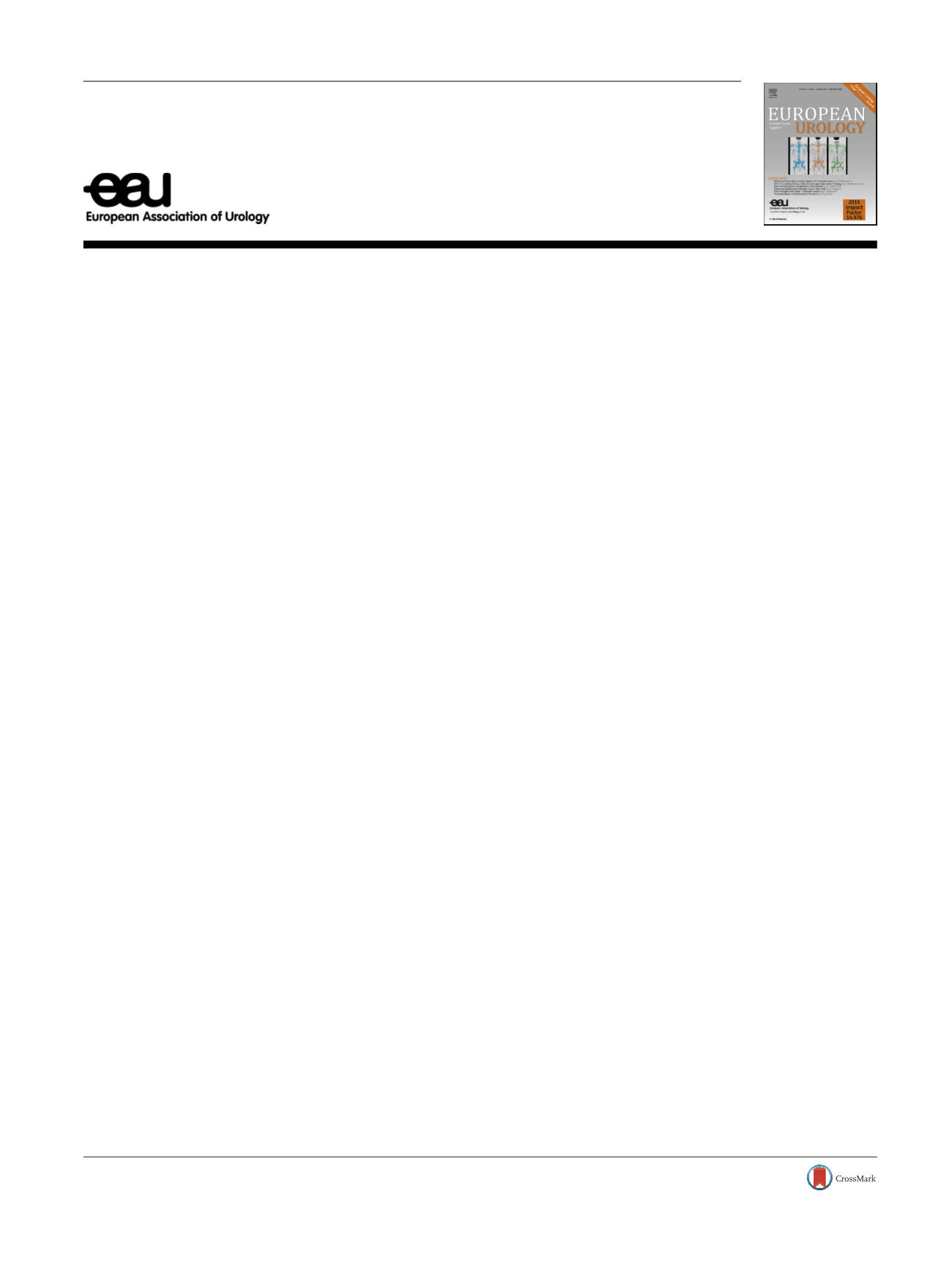

Letter to the Editor
Re: Maria Carmen Mir, Ithaar Derweesh,
Francesco Porpiglia, Homayoun Zargar,
Alexandre Mottrie, Riccardo Autorino.
Partial Nephrectomy Versus Radical Nephrectomy
for Clinical T1b and T2 Renal Tumors: A Systematic
Review and Meta-analysis of Comparative Studies.
Eur Urol 2017;71:606–17
The
[7_TD$DIFF]
authors are to be congratulated for this remarkable
meta-analysis of the role of partial nephrectomy (PN) and
radical nephrectomy (RN) for larger tumors by
[1_TD$DIFF]
[1]
[8_TD$DIFF]
, which
demonstrated the challenges in performing PN for rela-
tively large localized renal tumors (including T1b and T2)
and compared the performance of PN and RN. However,
several points need to be highlighted for a better
understanding.
First, an important study
[2]
regarding this issue is
missing in the review, even though it was published before
December 2015, which was the deadline for the search.
Because the details of the authors’ search strategy are not
included, the precise reason for this missing study cannot be
identified. However, concurrent use of search engines such
as PubMed and Ovid is one possible reason because the
basis for both search engines is Medline, which hinders the
breadth of their searches.
[9_TD$DIFF]
Pignot et al
[2]
reported the role of
PN and RN in a large cohort of 1237 patients, among whom
342 had T1b diseases. That number of patients is not small
and their inclusion would certainly affect the results of the
study
[2_TD$DIFF]
.
Second, although the authors conducted a scientific
meta-analysis using flexible adoption of fixed and random
effect models, a random effect model would have to be used
to account for the possibility of a large degree of hidden
heterogeneity. Although the
I
2
value was not high, this does
not guarantee that the data were not truly heterogeneous.
Studies that included possible heterogeneity were given
low weights; hence, the degree of heterogeneity could be
represented as low.
Third, the studies included were performed before 2010,
so the surgical techniques used could have been somewhat
[10_TD$DIFF]
outdated. Moreover, only one of all of the studies included
used robotic surgical techniques. The use of robotic PN is
greatly increasing, and
[11_TD$DIFF]
can
[12_TD$DIFF]
decrease warm ischemia
[13_TD$DIFF]
time,
even for complex tumors, and
[14_TD$DIFF]
can decrease the volume of
blood lost
[4_TD$DIFF]
[
[15_TD$DIFF]
3]
.
To overcome the abovementioned shortcomings,
search strategies should include all PN studies with or
without RN and not set up filtering for T stage or
comparison studies between PN and RN. Using such a
method, large national cohort-based studies and studies
with robotic PN could be included in the analysis
[
[16_TD$DIFF]
4]
. If
the outcome measures for PN and RN are not compatible,
additional meta-regression analyses that identify possible
[17_TD$DIFF]
modifiers, including age, cancer stage, surgical type, and
surgical procedure, are one possible solution. Single-
group meta-analysis is another reasonable option, espe-
cially for robotic RN, to overcome the
[18_TD$DIFF]
older data-based
meta-analyses currently in use.
Conflicts of interest:
The authors have nothing to disclose.
Acknowledgments:
This work was supported by Soonchunhyang
University Research Fund. The sponsor played a role in manuscript
preparation.
References
[1]
Mir MC, Derweesh I, Porpiglia F, Zargar H, Mottrie A, Autorino R. Partial nephrectomy versus radical nephrectomy for clinical T1b and T2 renal tumors: a systematic review and meta-analysis of comparative studies. Eur Urol 2017;71:606–17.
[2]
Pignot G, Mejean A, Bernhard JC, et al. The use of partial nephrec- tomy: results from a contemporary national prospective multicen- ter study. World J Urol 2015;33:33–40.
[3
[5_TD$DIFF]
]
Maurice MJ, Ramirez D, Malkoc E, et al. Predictors of excisional volume loss in partial nephrectomy: is there still room for improve- ment? Eur Urol 2016;70:413–5.[
[16_TD$DIFF]
4]
Pettus JA, Jang TL, Thompson RH, Yossepowitch O, Kagiwada M, Russo P. Effect of baseline glomerular filtration rate on survival in patients undergoing partial or radical nephrectomy for renal corti- cal tumors. Mayo Clin Proc 2008;83:1101–6.
E U R O P E A N U R O L O G Y 7 2 ( 2 0 1 7 ) e 1 2 7 – e 1 2 8ava ilable at
www.sciencedirect.comjournal homepage:
www.eu ropeanurology.comDOI of original article:
http://dx.doi.org/10.1016/j.eururo.2016.08.060.
http://dx.doi.org/10.1016/j.eururo.2017.05.0170302-2838/
#
2017 European Association of Urology. Published by Elsevier B.V. All rights reserved.
















